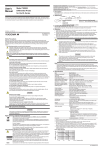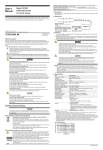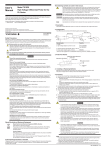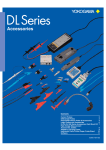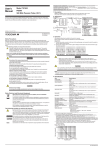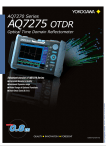Transcript
User's Manual YOKOGAWA ELECTRIC CORPORATION, Communication & Measurement Business Headquarters Phone: (81)-422-52-6768 9-32, Nakacho 2-chome, Musashino-shi, Tokyo, 180-8750 JAPAN YOKOGAWA CORPORATION OF AMERICA Phone: (1)-770-253-7000 YOKOGAWA EUROPE B.V. Phone: (31)-33-4641858 Databankweg 20, 3821 AL, Amersfoort, THE NETHERLANDS 2 Dart Road, Newnan, Ga. 30265-1094, U.S.A. YOKOGAWA ENGINEERING ASIA PTE. LTD. Phone: (65)-62419933 5 Bedok South Road, Singapore 469270, SINGAPORE Model 700924 Differential Probe for the DL Series 1 Description By using this device, oscilloscopes with single-ended input can be easily used as oscilloscopes with differential inputs. 2 Appearance Thank you for purchasing the Differential Probe (Model 700924) for the DL series. To ensure correct use, please read this manual thoroughly before beginning operation. After reading the manual, keep it in a convenient location for quick reference whenever a question arises during operation. 90 cm 25 cm 1 ADJUST (DC offset adjustment) 2 Optional Accessories (Sold Separately) 3 Standard Accessories 1 Probe Pinchers tip Black: B9852MM, Red: B9852MN 2 Pinchers tips Power cable* B9852MJ 3 Ground extention lead (length = 100 cm) * Power can be supplied from the DL, 700938, or 701934. 3 Installing/Replacing the Dry Cells Shift the lid at the back side of the probe and install/replace the four dry cells. The dry cells are not installed on receipt of the instrument. 4 Operation 1. Install four AA cells. When using an external power supply, do not install the dry cells. Supply 7th Edition : October 2007 (YK) All Rights Reserved, Copyright © 2007, Yokogawa Electric Corporation power only through the external power supply. 2. Simply plug-in the BNC output connector to the vertical input of a oscilloscope, and connect the auxiliary grounding terminal to a proper ground. If necessary, use a ground extention lead. IM 700924-01E 7th Edition 3. Select the proper range setting. For higher resolution and less noise when measuring signals below 350V, switch the attenuation to 1/100. Otherwise, set the attenuation to 1/1000 when measuring signals above 350V. 4. If the offset voltage is large, short the top of input leads, and turn the ADJUST variable resistor (DC voltage adjustment) using a flat-head screwdriver to adjust the offset voltage. 5. Using the appropriate probe accessories, connect the input to the circuits under measurement. Safety Precautions Make sure to comply with the safety precautions mentioned hereafter when handling the probe. Yokogawa Electric Corporation assumes no responsibility for any consequences resulting from failure to comply with these safety precautions. Also, read the User’s Manual of the measuring instrument thoroughly so that you are fully aware of its specifications and handling, before starting to use the probe. The following symbols are used on this instrument. Warning: handle with care. Refer to the user’s manual or service manual. This symbol appears on dangerous locations on the instrument which require special instructions for proper handling or use. The same symbol appears in the corresponding place in the manual to identify those instructions. Risk of electric shock Make sure to comply with the following safety precautions in order to prevent accidents such as an electric shock which impose serious health risks to the user and damage to the instrument. Note • Connect the BNC connector to the input terminal of the oscilloscope and for two point measurement (differential measurement), connect both input leads. Because the performance declines in case you carry out measurements with only one input lead connected, make sure to always connect both. • Accurate measurement may not be possible near objects with strong electric fields (such as cordless equipment, transformers, or circuits with large currents). 5 Specifications Item Frequency bandwidth*1 Input type Attenuation ratio Output offset voltage*1 *2 Input resistance and capacity Differential allowable voltage (between + − terminal) Max common mode voltage Max input voltage(to ground) CMRR (typical)*1 Output voltage*1 Output impedance Gain accuracy*1 CAUTION Maximum input voltage Do not apply any voltages exceeding the maximum input voltage to the probe. Correct use of the power supply Power the probe with either 4 AA dry cells, a 6 VDC/200 mA or 9 VDC/150 mA external power supply, or by connecting the probe’s power cable to a probe power supply terminal on a DL series measuring instrument or to the 700938 or 701934. Operating the probe under a power supply greater than the voltage specified above may cause damage to the instrument. Connecting the external power supply to the probe Always turn OFF the probe’s power switch when connecting or disconnecting the external power supply. Also, do not install the dry cells when using an external power supply. Operating environment Storage environment Operating altitude Power requirements*3 Cell life time Dimensions Weight Withstanding voltage Operating environment limitations See below for operating environment limitations. CAUTION • This probe is to carry out differential measurement between two points on the circuit under measurement. This probe is not for electrically insulating the circuit under measurement and the measuring instrument. • Use a soft cloth to clean the dirt. Prevent damage to the probe. Avoid immersing the probe, using abrasive cleaners, and using chemicals contains benzene or similar solvents. WARNING Grounding of the measuring instrument The protective grounding terminal of the measuring instrument must be connected to ground. Earth cable of the probe Make sure to connect the earth cable of the probe to the ground (grounding potential). Do not operated with suspected failures If you suspect that there is damage to this probe, have it inspect by a service personnel. Observe maximum working voltage To avoid any injury,do not use the probe above 1400 Vpeak between each input lead and earth or between the two inputs. This voltage rating applies to both 1/100 and 1/1000 settings. Must be grounded This probe must be grounded with the BNC shell and an auxiliary grounding terminal, through the grounding conductor of the power cord of the measuring instrument or other appropriate grounding conductor. Before making connections to the input terminals of the product, ensure that the output connector is attached to the BNC connector of the measuring instrument and the auxiliary grounding terminal is connected to a proper ground, while the measuring instrument is properly grounded. Do not operate without cover To avoid electric shock or fire hazard, do not operate this probe with the cover removed. Do not operate in wet/damp conditions To avoid electric shock, do not operate this probe in wet or damp conditions. Do not operate in explosive atmosphere To aviod injury or fire hazard, do not operate this probe in an explosive atmosphere. Avoid exposed circuitry To avoid injury, remove jewelry such as rings, watches, and other metallic objects. Do not touch exposed connections and components when power is present. WARNING • To protect against electric shock the ground side of the output cable (the shielded side of the BNC connector) must be grounded. • Make sure to avoid an electric shock when connecting the probe to the object of measurement. Do not remove the probe from the measuring instrument after the object of measurement is connected. • When disconnecting the probe BNC output connector, first turn OFF the power to the circuit under measurement. Then, disconnect the probe from the high voltage parts of the circuit under measurement. • When replacing batteries or connecting an external power supply, first turn OFF the power to the circuit under measurement. Then, remove the input lead from the circuit under measurement. Safety standards CAUTION This product is a Class A (for industrial environments) product. Operation of this product in a residential area may cause radio interference in which case the user is required to correct the interference. Emission Waste Electrical and Electronic Equipment Waste Electrical and Electronic Equipment (WEEE), Directive 2002/96/EC (This directive is only valid in the EU.) This product complies with the WEEE Directive (2002/96/EC) marking requirement. This marking indicates that you must not discard this electrical/electronic product in domestic household waste. Product Category With reference to the equipment types in the WEEE directive Annex 1, this product is classified as a “Monitoring and Control instrumentation” product. Do not dispose in domestic household waste. When disposing products in the EU, contact your local Yokogawa Europe B. V. office. Immunity *1 *2 *3 *4 When the power supply voltage from the dry cells is 5 V or more, or when using an external power supply. Ambient temperature 23±5°C When the capacity of dry cells goes down LED blinks. In such a case, replace the dry cells. Also, do not install the dry cells when using an external power supply. This equipment is for measurement category III (CAT III). Do not use it with measurement category IV (CAT IV). CAT III applies to measurement of the distribution level, that is , building wiring, fixed installations. CAT IV applies to measurement of the primary supply level, that is, overhead lines, cable systems, and so on. *5 Pollution degree applies to the degree of adhesion of a solid, liquid, or gas which deteriorates withstand voltage or surface resistivity. Pollution degree 2 applies to normal indoor atmospheres (with only nonconductive pollution). The Following Symbols are Used in this Manual. Improper handling or use can lead to injury to the user or damage to the instrument. This symbol appears on the instrument to indicate that the user must refer to the user’s manual for special instructions. The same symbol appears in the corresponding place in the user’s manual to identify those instructions. In the manual, the symbol is used in conjunction with the word “WARNING” or “CAUTION.” WARNING Calls attention to actions or conditions that could cause serious or fatal injury to the user, and precautions that can be taken to prevent such occurrences. CAUTION Calls attentions to actions or conditions that could cause light injury to the user or damage to the instrument or user’s data, and precautions that can be taken to prevent such occurrences. Note Calls attention to information that is important for proper operation of the instrument. Input voltage derating Max input voltage (V) Specifications DC to 100 MHz (−3 dB) Balancing difference input switched ratios of 100:1 and 1000:1 ±7.5 mV 4 MΩ + 10 pF each side to ground ±1400 V (DC + ACpeak) or 1000 Vrms at 1000:1 attenuation ±350 V (DC + ACpeak) or 250 Vrms at 100:1 attenuation ±1400 V (DC + ACpeak) or 1000 Vrms ±1400 V (DC + ACpeak) or 1000 Vrms 60 Hz: less than −80 dB; 1 MHz: less than −50 dB ±3.5 V (DC + ACpeak) Using 1 MΩ input system oscilloscope ±2% (common mode voltage ≤ 400 V and ≥ −400 V) ±3% (common mode voltage ≤ 1000 V and ≥ −1000 V) 5 to 40°C, 25 to 85% (no condensation) −30 to 60°C, 25 to 85% (no condensation) 2,000 m or less Internal battery: four dry cells (AA, R6) External power supply: 6 VDC/200 mA or more, or 9 VDC/150 mA or more. From the DL series instrument’s probe power supply, 700938, or 701934 using the probe’s power supply cable. In continuous duty, approx. 2 hours 207 mm × 83 mm × 38 mm (excluding connector and cable) Approx. 800 g ( excluding the dry cells) 2000 VACrms (between input terminal and BNC-ground), for 5 minutes Complying standards EN61010-031 Measurement category III*4: 1400 V (DC + ACpeak) Pollution degree 2*5 Complying standards EN61326, EN55011, EN61000-3-2, EN61000-3-3 This product is a Class A (for industrial environment) product. Operation of this product in a residential area may cause radio interference in which case the user is required to correct the interference. Complying standards EN61326 1400 1000 100 10 0.1 M 1M 10 M 100 M Frequency (Hz) IM 700924-01E

